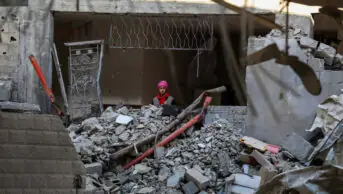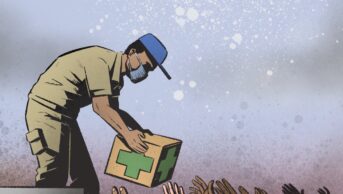
Bill and Melinda Gates Foundation
Trevor Mundel is president of the global health division at the Bill and Melinda Gates Foundation. During the neglected tropical disease (NTD) summit in Geneva, Switzerland, on 19–22 April 2017, Bill Gates, co-chair of the foundation, committed another US$335m (£265m) in grants over four years on NTD programmes. Overall, governments and private donors, including pharmaceutical companies, pledged more than US$800m (£628m) in new commitments, which included US$460m (£361m) from the UK government. In 2015, almost 1 billion people were treated for at least one NTD out of 1.5 billion who required preventive treatment, up 36% from 2011.
Relieving the supply problem has led to acceleration in the programme
A native of South Africa, Mundel earned his bachelor’s and medical degrees from the University of the Witwatersrand in Johannesburg. He also studied mathematics, logic and philosophy as a Rhodes Scholar at the University of Oxford and holds a PhD in mathematics from the University of Chicago. Before joining the foundation in 2011, where he leads efforts in research and development of vaccines, drugs and diagnostics to address major global health challenges, Mundel was global head of development with Novartis. Previously, he was involved in clinical research at Pfizer and Parke-Davis.
Since the London Declaration on Neglected Tropical Diseases (NTDs) — a collaborative disease eradication programme launched on 30 January 2012 to eliminate ten of the most common NTDs — what has been the progress?
In 2012, there was frustration that we have effective drugs, but we don’t have supply of those drugs. They could be cheap, but the suppliers are not supplying them. So that was the first step. Therefore, it was crucial that the World Health Organization (WHO) stepped in and worked with the pharma companies, which was not an easy thing. It was a brave step for Margaret Chan, the outgoing director-general of the WHO, to decide to work collaboratively with the pharmaceutical industry. The industry responded positively, so relieving the supply problem has led to acceleration in the programme. Today we have more than 7 billion treatments donated by 10 pharmaceutical companies since the declaration. As soon as the donations started to come in, we did not have the infrastructure to receive and distribute them in a way that we like.
Bill Gates says some NTDs are on target for elimination by 2020 (such as lymphatic filariasis), some by 2025 and some by 2030. How realistic are these targets?
I do not think elimination of lymphatic filariasis (LF) — also known as elephantiasis — is going to occur by 2020, but we’ll make significant progress. Nine countries are on track to meet the 2020 target for LF, but the one thing that might help this is a new triple therapy for it. When combined, three existing drugs — ivermectin, albendazole and diethylcarbamazine — were shown to increase efficacy of LF treatment. We expect guidance will be issued from WHO within the next few months.
By using geospatial mapping, we are getting a much better picture on how we can eliminate some NTDs
The foundation has also been financing clinical trials for new NTD drugs. What are some of these?
We financed the Drugs for Neglected Disease initiative (DNDi) trial for the new drug fexinidazole for sleeping sickness. There is an even more promising drug, SCYX-7158, that is also undergoing trials, which requires just one dose. The research for the triple drug therapy for LF is expensive and we wanted to help accelerate that, so we helped fund the drug. The first trial was in Papua New Guinea, then we had another study in the Ivory Coast. Now we just finished a study in India, and there is one still ongoing in Haiti and Indonesia.
How is the foundation using information and communications technologies to map and trace NTD cases, especially in remote communities?
Our biggest focus is trying to get the data and analytics right. That’s why some of our biggest investment is in data groups such as the Institute of Health Metrics and Evaluation, based at the University of Washington in Seattle.
The institute uses geospatial mapping from satellite images to identify people at risk of contracting rare diseases such as trachoma, a contagious bacterial infection of the eye. A project that concluded in 2015 used a smartphone-based mapping system to track 100 million previously unidentified people at risk of the disease.
By using such technology, we are getting a much better picture on how we can eliminate some NTDs. For example, after 2012, river blindness (onchocerciasis) was eliminated, whereas previously we were only able to control it. When you started to re-map and see how many people you need to be treating to achieve disease elimination, the numbers that needed to be treated had increased dramatically.
Some of the new drugs, such as AmBisome for visceral leishmaniasis, are costly, with the therapy at around US$160–US$250 (£125–£195) per case. Will the disease be difficult to eliminate even with effective drugs?
Visceral leishmaniasis (VL, caused by protozoan parasites) has a horrendous mortality rate. If left untreated, it is 90% lethal. The treatment is highly effective. But VL requires case management, so we are not going to be able to get rid of it. Fortunately, the sand fly, which is the vector, is a pretty shoddy vector. It was almost eliminated when people were using the insecticide dichlorodiphenyltrichloroethane (DDT) during the 1960s to combat malaria. Rates of infection and deaths went down to low levels, but then went up again because people had lost focus on it. When we started the mapping programme we noticed there was a rising problem of sand flies becoming resistant to DDT. As a result, we switched to pyrethroid insecticides, which they are not resistant to. Proper residual spraying of insecticides is what makes the difference — it is not going to be the treatment that will save people from dying.
How do you keep the momentum at the corporate, multilateral, and government levels when elimination of NTDs sounds like such a huge challenge?
We have to be smart about what we are going to achieve. When we are talking about elimination we don’t necessarily mean zero cases. Sometimes it means fewer than 1 per 10,000. For each of the NTDs, there’s a certain level below which there is no longer active transmission. You don’t have to do the mass drug administration as long as you follow individual cases when they materialise and track where they came from.
The next big vaccine in the respiratory area is for the respiratory syncytial virus
As long as you carry out surveillance, some of the NTDs can ‘bubble along’ for 10 or 15 years with few cases of infection. As such, sometimes we aim for a 95% reduction, and of course there will be some random cases that might occur.
How crucial are new diagnostics for surveillance?
Extremely. For example, a new effort we launched about 18 months ago is called CHAPS (childhood mortality prevention surveillance programme). We established centres of excellence in Africa and South Asia, and they will be the hubs of wider networks that will be collecting surveillance data, such as the causes of death. Initially, we’ll focus on mothers and children aged under five years old, but potentially we will expand to adult diseases as well. You can cover all of Africa with about 15 to 20 centres. Each centre costs about US$2m–US$3m to finance. We can finance about six. We’re in the market for partners to finance this important part of our programme.
What are some of your priority areas in vaccines, which make up about 60% of what you do, and are there any new initiatives on the horizon?
We want to get the pentavalent, rotavirus and the pneumococcal vaccines to all children. Currently, 40% of the cost of that package is coming from the pneumococcal vaccine, which is the most expensive of that group. So we’re looking at how we can reduce the expense of this to increase cost effectiveness.
The next big vaccine in the respiratory area is for the respiratory syncytial virus. It is probably the biggest cause of respiratory problems in young children. It may not have the high mortality rates that pneumococcal has, but it causes a huge amount of hospital admissions. We’re planning to give the vaccine to mothers in their last trimester of pregnancy. The mother produces the antibodies and they transfer across the placenta to the child. There’s an advanced study ongoing in South Africa and we hope to have the results by the end of the year.

